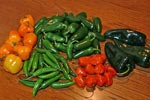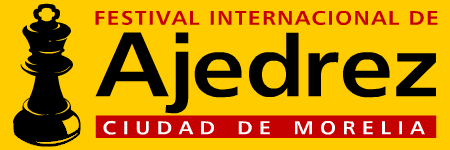
Halftime in Morelia/Linares
The first half of the Super-GM tournament in Morelia/Linares has ended, and
the final table shows Indian GM Vishy Anand and Norwegian wonderboy Magnus Carlsen
in the lead.
If we look at the statistics of the games we see that the drawing quotient
was 64%, which is not unusual in tournaments of this calibre.
Peter Svidler is the only player to draw all his games (but see below). Anand
and Carlsen had the least number of draws: just three apiece. Both players lost
one game and won three. The performances of the two leaders are: Carlsen 2855,
Anand 2842 (Carlsen had to face stiffer opposition because it included the higher-rated
Anand). Morozevich has the lowest performance rating, 2587, but not for lack
of ability and fighting spirit. He was probably the unluckiest player in the
field. Veselin Topalov played well below par, with a performance of 2691, 92
points less than one would have expected.
Let us compare the cross table of this year's event with that of the previous
edition, which had Radjabov, Vallejo and Bacrot instead of Anand, Carlsen, and
Morozevich:
Morelia/Linares 2006 at halftime

Peter Leko was leading at this stage of the event last year, with two points
more than he scored this year. Topalov was even worse in 2006, with 2.5 out
of 7. But he managed to score 5½ out of 7 in the second half and almost
caught Aronian, who won the tournament with 8.5/14 points. Peter Leko collapsed
with just 2½ out of 7 in the second half to end fourth. It is impossible
to predict what will happen this time: will Topalov come back with a dramatic
winning spree in the second half? Will any player break down as Leko did in
the previous year? Will Magnus Carlsen be able to keep up his incredible performance?
Whatever happens it is sure to be quite exciting.
The second half of the tournament starts on Friday, the 2nd of March, in the
Hotel Anibal in Linares, Spain, and ends on Saturday, March 10th. You will find
the full schedule at the bottom of this page.
Departure from Morelia 2007
Picture report by Frederic Friedel

The final round of the first half of the Morelia/Linares Super-GM

We haven't had a really good scandal for a number of weeks now. In case you
are experiencing withdrawal symptoms here's a question: what on earth was Veselin
Topalov wearing during his games?
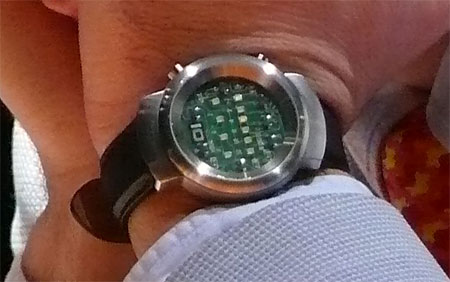
We take a closer look: some sort of radio device use to receive chess moves?!
We confronted Veselin and got a less ominous explanation.
Think geek! He is wearing a binary watch which requires you to press a button
and translate
the two rows of LEDs that light up into the current time. Some people have
too much free processing power in their heads.
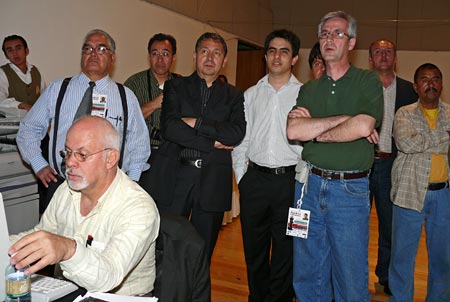
In the press room journalists and organisers wait for results during the final
exciting moments
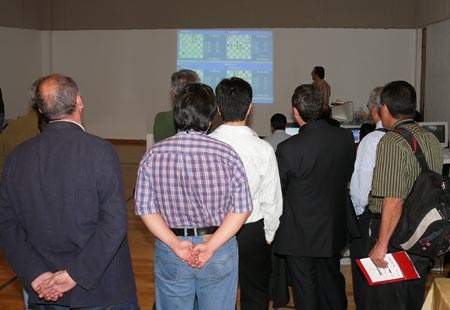
The games are transmitted live and projected on the wall at the back of
the room

In the press room: GM Alexander Motylev, Peter Svidler's second
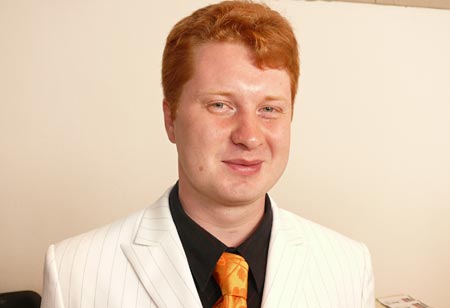
GM Vladimir Potkin, the second of Levon Aronian

IM Guil Russek, the author of a number of very nice chess books
My favourite Russek book is Ajedrez
Artístico, a collection of extraordinary chess studies, beautifully
annotated. The price is around US $8.50 and it is definitely to be recommended
for anyone who can understand a smattering of Spanish. Guil has a wry sense
of humour and has taught me more about Mexico than practically anybody else.
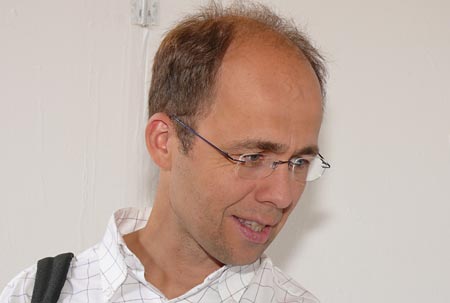
Henrik Carlsen, Magnus's father and second
Henrik Carlsen is not as strong as his son – at least five hundred points
weaker on the Elo scale. But he is an excellent coach and companion. In Linares
he will be replaced by the usual second, GM Peter Heine Nielsen. Magnus, we
are told, works harder when Henrik is around – with Peter Heine the two
are up to more mischief.
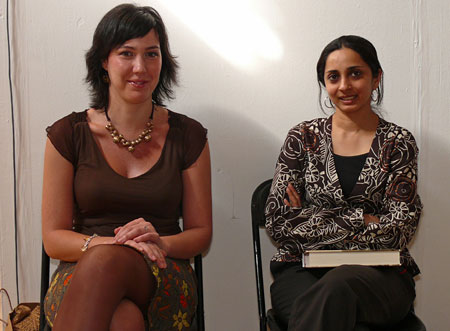
Yes, still there – same ladies, different outfits: Pilar Molina and
Aruna Anand

On the last day they are joined by Veronica Saggiante, wife of the sponsor
and
organiser of this year's World Championship in Mexico City, Jorge Saggiante
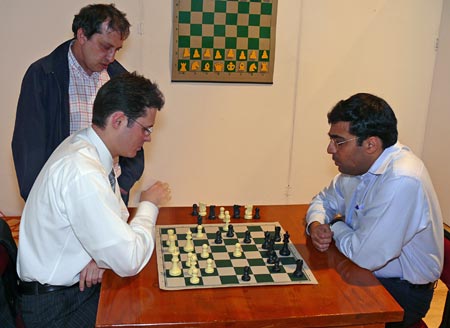
Vishy Anand (right) analyses the game he won against Peter Leko, watched
by
Peter's second and father-in-law GM Arshak Petrosian
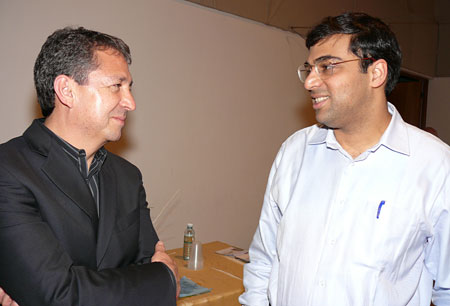
Jorge Saggiante and Vishy Anand – they'll be seeing a lot of each other
later this year
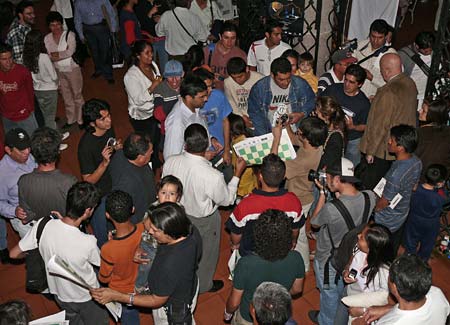
Anand getting mobbed when leaving the theatre

The brief closing ceremony – more a cocktail party – in a town
hall in Morelia
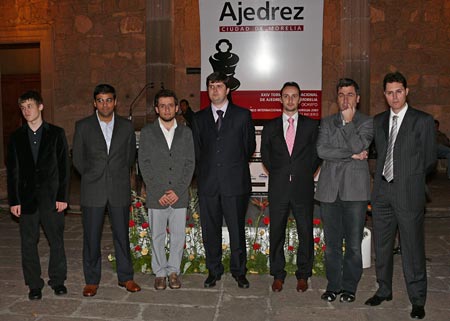
The players lined up for a group photograph: Carlsen, Anand, Aronian, Svidler,
Topalov, Ivanchuk, Leko. Tail-ender Morozevich did not attend the ceremony.
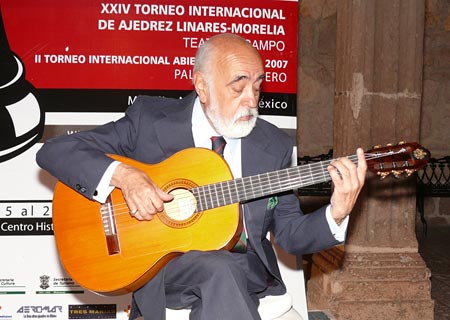
Some fine guitar music to entertain the guests
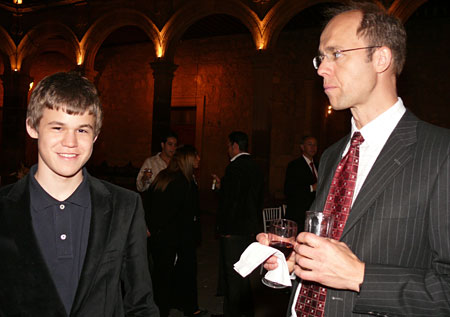
Magnus and his father Henrik Carlsen
Initially Magnus looked quite awestricken by the attention paid to him by the
media. That is hardly surprising, given that the 16-year-old had to suffer daily
attacks by hordes of photographers equipped with flash guns and video cameras.
At the start of a game a dozen flashes would go off whenever he touched a chess
piece.
In the last couple of days Magnus began to relax and turn into a regular, very
affable young man. He has a taste for good logical puzzles, of which his father
has a great store. Here's one we hadn't heard before: FIDE stages a knockout
tournament with n players (say 131). To make up for the uneven number, a complicated
system of seedings is used, of which we do not know the details. The matches
are one game each. How many games are played in total? Hint: you can calculate
the answer in a few seconds, for any value of n. Incidentally Henrik solved
the guillotine
problem in just around five minutes. Young Magnus pondered over it for considerably
longer.

The tournament in Morelia was a great success for all the participants. As
mentioned before, we were all treated like kings, stayed in fine hotels, getting
everything we wanted, quickly and always with an enchantingly friendly smile.
In the end we have only one serious complaint: nobody told us that our meal
vouchers – breakfast, lunch and dinner were all paid for by the organisers
– were also valid for one of the finest restaurant in Morelia, La
Conspiration, just minutes away from the players' hotel. Anand,
Aruna and I discovered this after a week in Morelia, and after that of course
went there every evening. On the very last day, Sunday, La Conspiration was
closed, and I have seldom seen Vishy so devastated. If I am not mistaken a tear
rolled down his cheek while we walked over to Los Juaninos, the players'
hotel, which has a first-class restaurant in its own right.
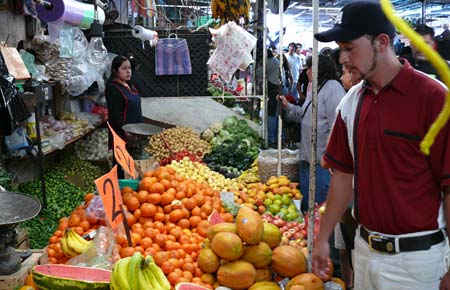
On Sunday I undertook a final very important visit: to the food
market of Morelia

This is a place where you don't just buy food, you actually eat it. The
smells that
fill the air cannot be described in words – you have to experience it
for yourself.
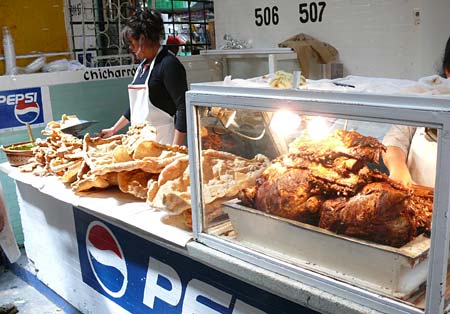
Chicharrones and carnitas,
offered all over the market for next to nothing
Chicharrones was introduced to me by IM Guil Russek (see above), a nice Jewish
boy who bought copious amounts of it and shared it with our group. Chicharrón
is pork rind that has been seasoned and deep fried. You can add salsa verde
(green chili sauce), or squeeze lime on them. Don't get started on it, you cannot
stop until you are thoroughly stuffed.

The reason my Mexican friends – Manuel, Jorge, Lorraina, Guil and Ricardo
– took me to the market was so I could buy an adequate supply of fresh
chilis to take home to Hamburg. In the above picture they are pretending to
eat habanero chiles, the deadliest of them all. Habaneros weigh in at 100,000
and 300,000 Scoville units,
enough to kill a horse at twenty paces (but see below).
I discovered recently why chilis are hot, from an evolutionary point of view.
Normally plants produce fruit so that they are plucked and eaten, and the seeds
may be transported by animals to distant locations. But what is the point of
producing a fruit that nobody in their right minds would touch (but see below)?
Well, it turns out that chili plants have specialised in being transported by
some birds (like parrots) which have no taste buds sensitive to capsaicin, the
chemical compound that makes chilis hot.
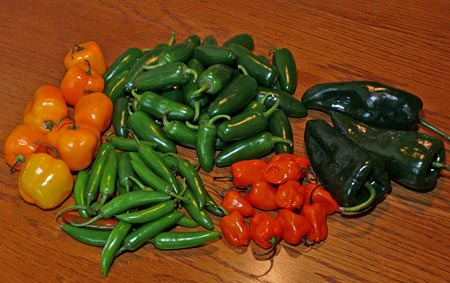
Above are the treasures I brought back with me to Hamburg. On the left are
the round chili manzana, on the top my favourite jalapeños, on the bottom
the hotter green seranos, on the right the sweet pablanos and, in the middle,
the deadly (but see below) orange-red habaneros. They will keep for over a month
in my refrigerator, an important factor when you live in a country where Mexican
chilis are not available, even in gourmet stores.
The Great Mexican Chili Challenge
On Moday, Febuary 26th, we were all transported to the International Airport
at Mexico City for our trip back to Europe. On our arrival we were told that
the Aero Mexico flight to Madrid was overbooked and that some of us would have
to remain behind. This news was taken with equanimity by some (like Vishy Anand,
who knew that the compensation was a night in a fine hotel, a free extra return
ticket to anywhere in the world, and $200 pocket money) or with sheer panic
(like Peter and Sofi Leko, until they learned about the compensation package).
In the end it turned out that it was all a false scare – everybody got
onto the flight and there were in fact half a dozen places free on the plane.
While passing through the baggage check my bag with the chilis sounded off
an alarm. Apparently capsaicin – at least a lot of it – can set
off the explosive substance detectors. In the end the guards who opened and
carefully checked the bag decided that this was just a European nutcase hooked
on Mexican food.
But the others saw what I was transporting, and Lev Aronian asked me to show
him some of the chilis. I pulled out a bag of dried pequin
chilis and handed him a few, with appropriate warnings (they are 30,000-40,000
on the Scoville scale). Levon ate them like popcorn. Peter Svidler joined the
fun and, after tasting a few, made snide remarks about how mild they were. Insulted
and bent on revenge, I pulled out one of the habaneros!
Levon tried a bit off the tip and pronounced this fruit completely harmless.
I tore off a bit and was also disappointed. But as I got lower down it suddenly
appeared – that terrifying burning sensation that causes your brain to
produce endorphins, natural opioids which ultimately leads to hot foods addiction. Of course the
bottom half with the seeds is the deadly part. Levon took half of this and chomped
away at it. He looked somewhat dazed and said: "Okay, this is seriously
hot." But he survived very nicely.
Then Peter Svidler insisted on taking up the challenge. He consumed the second
half, seeds and all, with a contented smile on his face. And I bowed to the
two great grandmasters of hot food, realising that, although a king in my native
Germany (where "hot food" means you can actually taste the meal) I
was nothing but a "chili wuss", as Lev put it, compared to these two.
I mean I can understand an Armenian like Aronian being up to it – they
are probably fed with blow torches as children. But that an aristocratic St.
Petersburg boy can take undiluted habaneros, is utterly beyond my comprehension.
For those of you who have held out this far here is the solution to Henrik
Carlsen's puzzle: if n players are participating in a single-round knockout
tournament, then in order for one to win n-1 players must lose a game each.
So for 131 players the number of games is 130. Q.E.D.
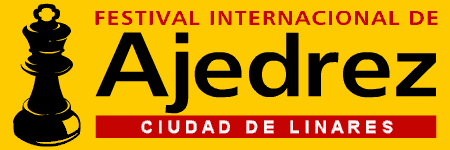
Schedule
Round 8: Friday, March 2nd |
Peter Leko |
- |
Vassily Ivanchuk |
Vishy Anand |
- |
Veselin Topalov |
| Levon Aronian |
- |
Peter Svidler |
Alex. Morozevich |
- |
Magnus Carlsen |
Games – Report |
|
Round 9: Saturday, March 3rd |
Alex. Morozevich |
- |
Peter Leko |
Magnus Carlsen |
- |
Levon Aronian |
Peter Svidler |
- |
Vishy Anand |
Veselin Topalov |
- |
Vassily Ivanchuk |
Games – Report |
|
Round 10: Sunday, March 4th |
Peter Leko |
- |
Veselin Topalov |
Vassily Ivanchuk |
- |
Peter Svidler |
Vishy Anand |
- |
Magnus Carlsen |
Levon Aronian |
- |
Alex. Morozevich |
Games – Report |
|
|
Free day: Monday, March 5th |
|
Round 11: Tuesday, March 6st |
Levon Aronian |
- |
Peter Leko |
Alex. Morozevich |
- |
Vishy Anand |
Magnus Carlsen |
- |
Vassily Ivanchuk |
Peter Svidler |
- |
Veselin Topalov |
Games – Report |
|
Round 12: Wednesday, March 7th |
Peter Leko |
- |
Peter Svidler |
Veselin Topalov |
- |
Magnus Carlsen |
Vassily Ivanchuk |
- |
Alex. Morozevich |
Vishy Anand |
- |
Levon Aronian |
Games – Report |
|
|
Free day: Thursday, March 8th |
|
Round 13: Friday, March 9th |
Vishy Anand |
- |
Peter Leko |
Levon Aronian |
- |
Vassily Ivanchuk |
Alex. Morozevich |
- |
Veselin Topalov |
Magnus Carlsen |
- |
Peter Svidler |
Games – Report |
|
Round 14: Saturday, March 10th |
| Peter Leko |
- |
Magnus Carlsen |
Peter Svidler |
- |
Alex. Morozevich |
Veselin Topalov |
- |
Levon Aronian |
Vassily Ivanchuk |
- |
Vishy Anand |
Games – Report |
|
|
Links
